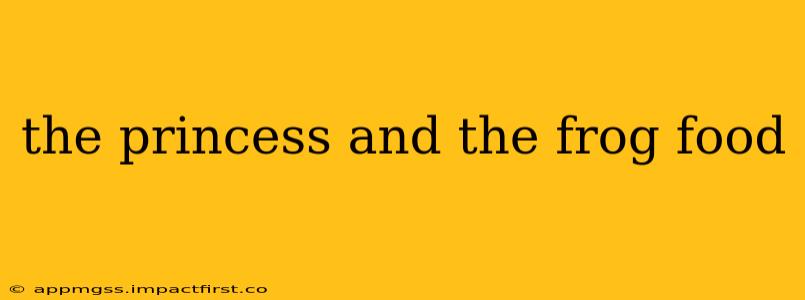Disney's "The Princess and the Frog" isn't just a charming animated film; it's a vibrant celebration of New Orleans culture, and a significant part of that celebration is the food. From beignets to gumbo, the film showcases a delicious array of Louisiana cuisine, leaving viewers hungry for more. This article dives deep into the culinary landscape depicted in the movie, exploring its significance and answering some frequently asked questions.
What Kind of Food is Featured in "The Princess and the Frog"?
The film beautifully portrays the rich diversity of New Orleans cuisine. We see everything from classic Cajun and Creole dishes to iconic New Orleans sweets. Key examples include:
- Gumbo: This quintessential Creole stew, often featuring okra, shrimp, chicken, and andouille sausage, makes multiple appearances, highlighting its importance in the city's culinary heritage.
- Beignets: These square, puffy fried dough pastries, dusted generously with powdered sugar, are a beloved New Orleans treat, and their irresistible appeal is perfectly captured in the movie.
- Jambalaya: While not explicitly shown in detail, the vibrant culinary scene strongly implies the presence of this iconic rice dish, filled with flavorful meats and vegetables.
- Po'boys: Although not directly shown, the bustling atmosphere of New Orleans suggests the prevalence of these delicious submarine sandwiches, filled with various meats, cheeses, and vegetables.
What is the Significance of Food in the Movie?
Food in "The Princess and the Frog" is more than just sustenance; it's a powerful symbol:
- Cultural Identity: The film showcases the diverse culinary traditions of New Orleans, emphasizing its unique blend of French, African, and American influences. The food acts as a visual representation of the city's rich and complex cultural history.
- Community: Many scenes revolve around food, highlighting its role in bringing people together. Shared meals create a sense of community and warmth, showcasing the importance of social connections in New Orleans culture.
- Transformation: The food itself undergoes a transformation, reflecting Tiana's journey. Her initial ambition is to open her own restaurant, a testament to her passion for culinary excellence, and her dedication to her dream is mirrored in her careful preparation of food.
What Restaurant Does Tiana Open in "The Princess and the Frog"?
Tiana's ultimate goal is to open her own restaurant, a dream that represents her hard work, dedication, and culinary expertise. While the film doesn't explicitly name the restaurant, it is visually established as a high-quality establishment reflecting Creole-inspired dishes and Tiana's personal touch. The restaurant itself is a symbol of her achieving her goal and fulfilling her potential.
Is the Food in "The Princess and the Frog" Realistic?
The food depicted in "The Princess and the Frog" is largely realistic and accurate in representing the visual and cultural aspects of New Orleans cuisine. While some artistic liberties are taken for animation purposes, the overall portrayal strives for authenticity, showcasing the vibrancy and diversity of the region's culinary heritage. The film's creators collaborated with culinary experts to ensure the accuracy and cultural sensitivity of the food representation.
Where Can I Find Recipes Inspired by "The Princess and the Frog"?
Many websites and cookbooks offer recipes inspired by the food in "The Princess and the Frog." A simple online search for "Princess and the Frog recipes" will yield a wide variety of options, allowing you to recreate some of the magical culinary experiences from the film in your own kitchen.
Through its vibrant depiction of New Orleans cuisine, "The Princess and the Frog" offers a delightful culinary journey alongside its enchanting storyline. The film effectively uses food not only as a delicious visual element but also as a powerful symbol of culture, community, and personal growth.
